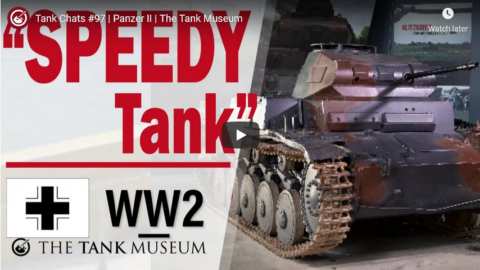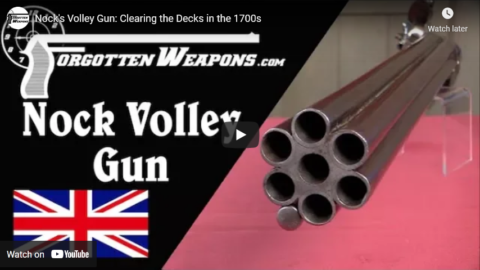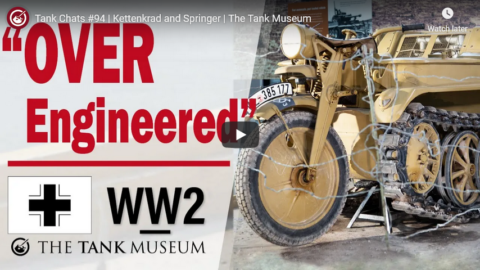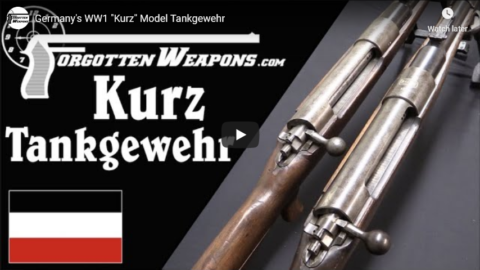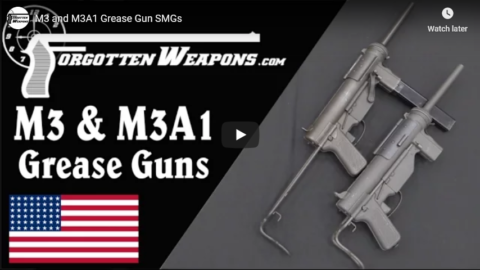The Tank Museum
Published 20 Mar 2020Here David Willey discusses the Panzer II, a German tank which was instrumental in the early days of the Second World War, especially during the Blitzkrieg.
Support the work of The Tank Museum on Patreon: ► https://www.patreon.com/tankmuseum
Visit The Tank Museum SHOP: ►tankmuseumshop.org
Twitter: ► https://twitter.com/TankMuseum
Instagram: ► https://www.instagram.com/tankmuseum/
Tiger Tank Blog: ► http://blog.tiger-tank.com/
Tank 100 First World War Centenary Blog: ► http://tank100.com/
#tankmuseum #tanks
March 2, 2021
Tank Chats #97 | Panzer II | The Tank Museum
February 12, 2021
Nock’s Volley Gun: Clearing the Decks in the 1700s
Forgotten Weapons
Published 3 Mar 2018The Nock Volley Gun was actually invented by an Englishman named James Wilson in 1789, and presented to the British military as a potential infantry weapons. This was declined as impractical, but the Royal Navy found the concept interesting for shipboard use. In 1790 the Navy ordered two prototypes made by the British gunsmith Henry Nock, and finding them suitable, proceeded to oder a total of 500 of the guns (thus forever associating Nock’s name with the gun instead of Wilson’s). A further 100 or so were ordered in 1797, and the guns were in fact issued out to various ships — although accounts of their use in combat are difficult to find.
Unfortunately for Nock, the guns presented a couple of substantial problems in use. One was simply the recoil of firing. A single 32-bore (approximately .55 caliber) round ball over 40 grains of black powder is not a very impressive load, but seven of them firing simultaneously add up to a recoil comparable to 4- or 6-bore rifles, and in a volley gun weighing just 13 pounds (5.9kg). In addition, the guns did not always reliably fire all barrels, especially when dirty. This produced a conundrum: how to determine which barrels had fired and which had not? The practical result was double-loaded barrels, which could be liable to bulge or burst. For these reasons, the weapon was declared obsolete in 1805, and never appeared to play any significant military role.
The gun did receive a new wave of popular awareness in 1960, when the character of Jim Bowie was outfitted with one in the movie The Alamo (against all historical evidence). His easy handling of the weapon and the waves of men he was able to mow down with it brought the gun back into the popular consciousness.
http://www.patreon.com/ForgottenWeapons
Cool Forgotten Weapons merch! http://shop.bbtv.com/collections/forg…
If you enjoy Forgotten Weapons, check out its sister channel, InRangeTV! http://www.youtube.com/InRangeTVShow
Contact:
Forgotten Weapons
6281 N Oracle #36270
Tucson, AZ 85704
February 11, 2021
Tank Chats #94 | Kettenkrad and Springer | The Tank Museum
The Tank Museum
Published 31 Jan 2020Here David Willey examines two WW2 German tracked vehicles. The first is the Sd.Kfz. 2, better known as the Kettenkrad, a light tractor. The second, the Springer, a demolition vehicle which was fundamentally a mobile bomb, which shared the Kettenkrad’s running gear and engine.
Support the work of The Tank Museum on Patreon: ► https://www.patreon.com/tankmuseum
Visit The Tank Museum SHOP: ►tankmuseumshop.org
Twitter: ► https://twitter.com/TankMuseum
Instagram: ► https://www.instagram.com/tankmuseum/
Tiger Tank Blog: ► http://blog.tiger-tank.com/
Tank 100 First World War Centenary Blog: ► http://tank100.com/
February 6, 2021
Hitler’s Zipper: The MG-42 Universal Machine Gun
Forgotten Weapons
Published 4 Nov 2020http://www.patreon.com/ForgottenWeapons
https://www.floatplane.com/channel/Fo…
Cool Forgotten Weapons merch! http://shop.bbtv.com/collections/forg…
The MG42 was developed to be a more reliable and easier to manufacture replacement for the MG34, although both would serve side by side until the end of World War Two. Designed by Grossfuss company engineer Werner Gruner with no previous military or small arms design experience, the MG42 used heavy stampings for its main assemblies, thus reducing German need for expensive and difficult to obtain alloyed steels.
As a practical matter, the MG42 had a much higher rate of fire than the MG34, at 1500-1600 rounds per minute (more than 50% faster than the MG34). This was deemed desirable to improve the effectiveness of suppressing fire and the density of the cone of fire, but naturally resulted in much higher ammunition consumption than other machine gun models.
This example is a very early production Gustloff example, with the early horizontal charging handle, unreinforced wooden stock, and adjustable front sight. It was most likely captured in North Africa from Rommel’s forces, as they were a primarily user of the very early MG42s.
Contact:
Forgotten Weapons
6281 N. Oracle #36270
Tucson, AZ 85740
February 3, 2021
Germany’s WW1 “Kurz” Model Tankgewehr
Forgotten Weapons
Published 29 Oct 2020http://www.patreon.com/ForgottenWeapons
https://www.floatplane.com/channel/Fo…
Cool Forgotten Weapons merch! http://shop.bbtv.com/collections/forg…
When the German Tankgewehr was introduced in May 1918, the first 300 or so guns were of a different pattern than the standard production that would follow (and of which about 16,000 would be made). The Kurz model had a barrel about 4 inches shorter than the standard, and was about 2 pounds heavier, because that barrel (although shorter) was much larger in diameter than the standard pattern.
Contact:
Forgotten Weapons
6281 N. Oracle #36270
Tucson, AZ 85740
February 2, 2021
.38 ACP Webley-Fosbery Automatic Revolver
Forgotten Weapons
Published 11 Nov 2020http://www.patreon.com/ForgottenWeapons
https://www.floatplane.com/channel/Fo…
Cool Forgotten Weapons merch! http://shop.bbtv.com/collections/forg…
The rarest variation of the Webley-Fosbery automatic revolver is the .38 ACP model. Only 341 of these were made by Webley, in an attempt to compete with the new semiautomatic pistols appearing on the market — most notably the Colt Model 1900 and Model 1902. The Colt was chambered for .38 ACP, a remarkable cartridge for its time — high velocity and semi-rimmed. Webley figured that an 8-shot Fosbery-type revolver would offer the same capacity and ballistics as the new Colt, but in a revolver format familiar to the British market. The design could load cartridges individually, but also offered use of an 8-shot moon clip. Unfortunately for Webley, British legislation in 1903 hampered civilian handgun ownership and the military was not interested at all because the bore was too small. Of the 341 originally made, some were finally converted to .455 caliber after years of sitting unsold in Webley’s warehouse.
This model makes a notable appearance in Dashiell Hammett’s novel The Maltese Falcon, which quite specifically identifies it as an 8-shot, .38 caliber Webley-Fosbery. In the movie version, Humphrey Bogart mistakenly says it is an 8-shot .45, however…
Contact:
Forgotten Weapons
6281 N. Oracle #36270
Tucson, AZ 85740
January 26, 2021
Tank Chats #92 | Challenger 2: Part 2 | The Tank Museum
The Tank Museum
Published 17 Jan 2020Part 2 of a two-part episode on Challenger 2 [part 1 was posted here]. As David Willey had so much to say about this British in-service vehicle, it has been split into two parts. The second part examines the Challenger 2 in service. David talks to soldiers currently serving on the Challenger 2, looks at where it has seen service and some of the tank’s features. With thanks to the British Army for their assistance.
Support the work of The Tank Museum on Patreon: ► https://www.patreon.com/tankmuseum
Visit The Tank Museum SHOP: ►tankmuseumshop.org
Twitter: ► https://twitter.com/TankMuseum
Instagram: ► https://www.instagram.com/tankmuseum/
Tiger Tank Blog: ► http://blog.tiger-tank.com/
Tank 100 First World War Centenary Blog: ► http://tank100.com/
#tankmuseum #tanks #challenger2 #britisharmy #davidwilleytankchat #davidwilleychallenger2
January 20, 2021
Tank Chats #92 | Challenger 2: Part 1 | The Tank Museum
The Tank Museum
Published 20 Dec 2019Part 1 of a two-part episode on Challenger 2. As David Willey had so much to say about this British in-service vehicle, it has been split into two parts. This first part looks at the design and development of Challenger 2. With thanks to the British Army for their assistance.
Challenger 1 video: https://www.youtube.com/watch?v=Lwcx7…
Support the work of The Tank Museum on Patreon: ► https://www.patreon.com/tankmuseum
Visit The Tank Museum SHOP: ►tankmuseumshop.org
Twitter: ► https://twitter.com/TankMuseum
Instagram: ► https://www.instagram.com/tankmuseum/
Tiger Tank Blog: ► http://blog.tiger-tank.com/
Tank 100 First World War Centenary Blog: ► http://tank100.com/
#tankmuseum #tanks
January 19, 2021
M3 and M3A1 Grease Gun SMGs
Forgotten Weapons
Published 14 Apr 2017The US began looking for a cost-effective replacement for the Thompson submachine gun in 1942, and the “Grease Gun” was the result. Designed by George Hyde (a noted firearms designer at the time) and Frederick Sampson (GM/Inland chief engineer), it was a very simple and almost entirely stamped firearm. Chambered for the .45ACP cartridge, it is notable for its very low rate of fire — 350-400 rpm, which made it quite controllable and easy to shoot for relatively inexperienced troops.
The M3 was a quite reliable gun (and what problems it did have were mostly due to its single-feed magazine and not the gun itself), but a revision program was begun in April 1944. This would produce the M3A1, which further simplified the design by removing the charging handle (which had been the one mechanical trouble point of the M3 anyway) and replacing it simply with a notch in the bolt to cock the gun with a finger.
While the M3 and M3A1 were replaced in front-line service in 1957, they would remain in military inventory as armament for tank crews and truck drivers until 1992 — quite the legacy for such a crude looking weapon!
http://www.patreon.com/ForgottenWeapons
Cool Forgotten Weapons merch! http://shop.bbtv.com/collections/forg…
If you enjoy Forgotten Weapons, check out its sister channel, InRangeTV! http://www.youtube.com/InRangeTVShow
January 12, 2021
Tank Chats #91 | Centurion Conway | The Tank Museum
The Tank Museum
Published 13 Dec 2019Here David Fletcher examines a prototype variant of the Centurion – the Conway, fitted with the American 120mm gun.
Support the work of The Tank Museum on Patreon: ► https://www.patreon.com/tankmuseum
Visit The Tank Museum SHOP: ►tankmuseumshop.org
Twitter: ► https://twitter.com/TankMuseum
Instagram: ► https://www.instagram.com/tankmuseum/
Tiger Tank Blog: ► http://blog.tiger-tank.com/
Tank 100 First World War Centenary Blog: ► http://tank100.com/
#tankmuseum #tanks
January 8, 2021
Renault’s Backwards Car
Big Car
Published 12 Oct 2020Renault’s Project 900 is certainly an odd-looking car, but it’s also a car designed to break new ground. It used innovative new materials and gave class-leading visibility to try to leapfrog the competition. It also seems they were trying to beat their competition in the “weird” category as well, which given they were up against Citroën was no mean feat! So, what happened to Renault’s backwards car, and what echoes of this strange but innovative design are there in today’s cars?
To get early ad-free access to new videos, or your name at the end of my videos, please consider supporting me from just $1 or 80p a month at https://www.patreon.com/bigcar
Link to my second channel – Little Car: https://www.youtube.com/littlecar
Get Big Car t-shirts, mugs or a tote bag at teespring.com/stores/bigcartv
#bigcar
January 5, 2021
Tank Chats #89 | Universal Carrier | The Tank Museum
The Tank Museum
Published 22 Nov 2019David Fletcher takes a look at the Second World War Universal Carrier, a light tracked armoured vehicle and the most produced armoured fighting vehicle of WW2.
Support the work of The Tank Museum on Patreon: ► https://www.patreon.com/tankmuseum
Visit The Tank Museum SHOP: ►tankmuseumshop.org
Twitter: ► https://twitter.com/TankMuseum
Instagram: ► https://www.instagram.com/tankmuseum/
Tiger Tank Blog: ► http://blog.tiger-tank.com/
Tank 100 First World War Centenary Blog: ► http://tank100.com/
#tankmuseum #tanks
December 30, 2020
Big-Bore Simplicity: the Serbu BFG-50A
Forgotten Weapons
Published 25 Sep 2020http://www.patreon.com/ForgottenWeapons
https://www.floatplane.com/channel/Fo…
Cool Forgotten Weapons merch! http://shop.bbtv.com/collections/forg…
The Serbu BFG-50A is one of only a couple self-loading .50 caliber rifles manufactured in the US. Work on its design began in 2008, and the first finished examples were produced in 2011. A total of about 500 have been made to date. Mechanically, it is a direct gas impingement action with a 3-lug rotating bolt. Weighing in at 23 pounds, it is significantly lighter than its closest comparison, the Barrett M82A1.
Contact:
Forgotten Weapons
6281 N. Oracle #36270
Tucson, AZ 85740
December 27, 2020
Origins of the Lee Enfield Rifle: Lee Metford Updates
Forgotten Weapons
Published 20 Sep 2020http://www.patreon.com/ForgottenWeapons
https://www.floatplane.com/channel/Fo…
Cool Forgotten Weapons merch! http://shop.bbtv.com/collections/forg…
The Lee Metford MkI had scarcely been introduced when it was modified into the MkI* pattern, This was quickly followed by the MkII and MkII*, the Lee Enfield MkI, and Lee Enfield MkI*. In essence, the changes were:
Lee Metford MkI*: Change of sights to traditional barleycorn and V-notch, and removal of the manual safety
Lee Metford MkII: Update to 10-round, double-feed magazine, move sling rearward, modify cleaning rod to clearing rod
Lee Metford MkII*: Addition of safety lever on cocking piece
Lee Enfield MkI: Change from Metford rifling to Enfield rifling
Lee Enfield MkI*: Clearing rod removedContact:
Forgotten Weapons
6281 N. Oracle #36270
Tucson, AZ 85740
December 21, 2020
Lee Metford MkI: Great Britain’s First Magazine Rifle
Forgotten Weapons
Published 14 Sep 2020http://www.patreon.com/ForgottenWeapons
https://www.floatplane.com/channel/Fo…
Cool Forgotten Weapons merch! http://shop.bbtv.com/collections/forg…
The British went into the 1880s with plans to adopt the Enfield-Martini as its new rifle, a single shot Martini-action rifle with essentially a sidesaddle of ready-access cartridges on the side of the receiver. It would be chambered for a new .402 caliber black powder cartridge. However, the Small Arms Committee begin looking into the possibility of a magazine rifle instead, and trials of 40+ different systems found three worth considering: a Lee rifle with a box magazine, a Lee rifle with a Bethel Burton magazine, and the Owen Jones rifle. As these trials were concluding, the discovery of smokeless powder threw a wrench in the plans.
After study of the Swiss 7.5×53.5mm cartridge, the British opted to develop a small bore .30 caliber round themselves, which would be the .303 British. This round, originally loaded with compressed black powder before the use of cordite, rendered the plans for the .402 caliber Enfield Martini obsolete. What would have been a justifiable territorial and reserve rifle alongside a .402 magazine rifle was now an orphan. With the new rifle in .303 caliber, a .402 single shot Martini was just an added logistical overhead. Instead, existing Martini rifles would eventually be converted to .303 British.
At any rate, the Lee rifle and magazine were chosen as ideal, and in 1888 a batch was made for field trials across the British Empire. Widely positive reports led to its formal adoption and the beginning of production in 1889 as the Magazine Rifle MkI – later retroactively renamed the Lee Metford MkI and colloquially known as the Long Lee. The example we have today has two very rare original features; an intact manual safety and Lewes pattern sights. Both of these would be quickly removed or replaced in service, and a Mk I* and MkII pattern followed shortly after the adoption of the MkI.
Contact:
Forgotten Weapons
6281 N. Oracle #36270
Tucson, AZ 85740

